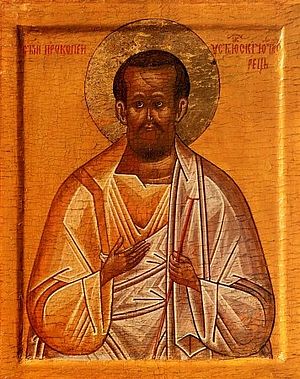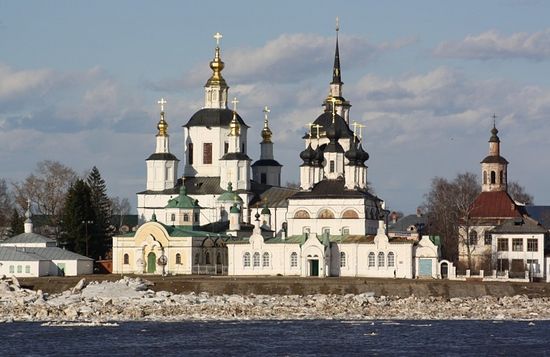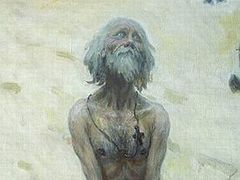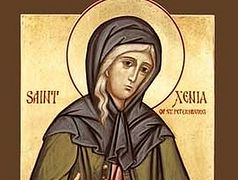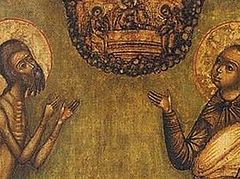“No matter where I look, I see everywhere the whole countenances of saints,” said one archpastor from Vologda. “I look to the west? There St. Paul of Obnora, Sts. Cornelius and Arsenius of Komel arise like spiritual firmaments in the refuge and stronghold of Christ’s warriors, to fend off visible and invisible enemies.
“I turn to the north, and there amidst the waves, on the rocky cliffs are holy Right-Believing Prince Ioasaph of Kamensk, and Sts. Peter and Vasily.
“I glance to the south? There on spiritual watch are the founders of Vologda churches—holy hieromartyrs Gerasim, Jonah, and Piterim.
I look to the East? There St. Procopius of Ustiug wards off with his prayers the raining rocks that threatening Veliky Ustiug…”
In our times, when true spiritual values are being unnoticeably replaced with material values, the story of the life of St. Procopius of Ustiug is quite edifying. Why is he so remarkable? He alone is one of the first fools-for-Christ in Russia. A wealthy German merchant, St. Procopius came to trade in Novgorod the Great. He was amazed that the grandeur of the churches and the piety of the people, and abandoned his former faith, homeland, and wealth, considering the true faith and importance of the spiritual life to be worth more than all these. But the path of his service would not be an easy one…
Having arrived in around 1243 on his a ship with his wares to Novgorod the Great, Procopius was involuntarily stunned by the multitude and splendor of the churches and monasteries, the beautiful ringing of scores of church bells, and the piety and fervency of the people for church services—something he never thought to see among a people who were not in submission to the Roman pope. Wishing to emulate the ascetic labors of the monks, he gave away all of his wares and the wealth left to him by his father to the poor and homeless of the city. He also donated part to the recently founded (1192) St. Varlaam of Khutyn Monastery, and entered it himself.
Here his spiritual director was the elder, Varlaam Prokshinich, who in all things imitated the monastery’s founder, Varlaam of Khutyn (+1192).
After all the Novgorodians began to pay him great respect, Procopius began his foolish-for-Christ.
When they learned that Procopius had received the holy faith and given away all his wealth, the citizens of Novgorod began to praise and exalt him. “This man is great before God, because he has left the evil faith for Orthodoxy, given all his wealth to the poor; and behold how he has of his own volition come to humility and poverty.” It was burdensome for Procopius to hear such talk about himself; this glory deprived him of peace and lay upon him like a heavy yoke. He revealed his sorrow to elder Varlaam and asked his advice—where should go he that know one would know him? Finally Procopius departed and became a wanderer. When he reached Veliky Ustiug, he stayed to live there on the steps of the Church of the Dormition of the Mother of God.
Procopius the Wonder-Worker
In 1290, Procopius foresaw a natural disaster—a fierce storm with hail, forest fires, and a tornado of terrible destructive power resulting from a meteorite that had fallen twenty versts (13 miles, 20 kilometers) from Veliky Ustiug. A week before the meteor fell, Blessed Procopius started walking around the town, tearfully calling the inhabitants to repent and pray that the Lord would save the city from the lot of Sodom and Gomorra. Throughout the week the righteous one warned of God’s coming judgment, but no one believed him. When the storm came on, the people ran to the most fortified and safest building in the city—the cathedral—where they found St. Procopius praying for them and for the city’s safety.
Church tradition has it that St. Procopius prayed before an ancient icon of the Annunciation, which was later transferred to Moscow. In honor of this icon, which received the name, the “Ustiug Icon of the Annunciation”, the Russian Orthodox Church celebrates on July 8/21 the “Sign from the icon of the Annunciation of the Mother of God in the city of Ustiug”.
Miracles after death
Procopius lived sixty years and departed from this world on July 8/21, 1303. After death he was numbered among the Orthodox saints.
In 1471, at the order of Grand Prince John II, soldiers gathered in Ustiug for the campaign against the Tatar city of Kazan. The Ustiug battalion, which had been stationed for a long time at an outpost in Nizhny Novgorod, fell victim to a serious, infectious disease called, “Fever and stomach sickness”. During this time of illness St. Procopius appeared to many of the soldiers in dreams, suggesting: “Place a vow on your heart to build a church in Ustiug in honor of Holy Righteous Procopius the Fool-for-Christ, and your illness will subide.” This was the beginning of his glorification, for all those who trusted this vision and made a vow to build a church soon recovered and returned safely to their native city; but those who considered the vision to be no more than a dream died from their illness. The surviving soldiers really did build a church upon their return to Ustiug, although they did not dedicate it to St. Procopius, but to Sts. Boris and Gleb and Great Martyr George. When this church was struck by lightening and burned down on August 1/14, 1490 as if in punishment for disobeying St. Procopius, the citizens of Ustiug built in 1495 a new church dedicated to Righteous Procopius.
There are other instances of healings from St. Procopius. The first recorded incident was of an Ustiugian named Gregory, who suffered from delirium, and having become totally paralyzed asked to be carried to the wonder-worker’s tomb. He was brought by boat to the church, and when they prayed a moleben and touched him to the reliquary, the sick man felt completely healthy and returned home without any help.
Commemoration of the Saint
The Church canonized Blessed Procopius at a Council in Moscow in 1547, and his commemoration date was established as July 8/21.
Today the cathedral of Rigteous Procopius is one of the most beautiful churches in Veliky Ustiug. Why was this magnificent church built on the tall banks of the Sukhona River? According to a legend, on this spot there is a rock that fell during that meteoric storm, from which St. Procopius had saved the city by his prayers. This rock has miraculous powers—St. Procopius blesses everyone who sits on it and prays the fervent prayer of his heart. The church and the Veliky Ustiug historical-architectural and art museums have joined forces to preserve and restore the gold-gilded, five-level iconostasis, which dates to the eighteenth century.

